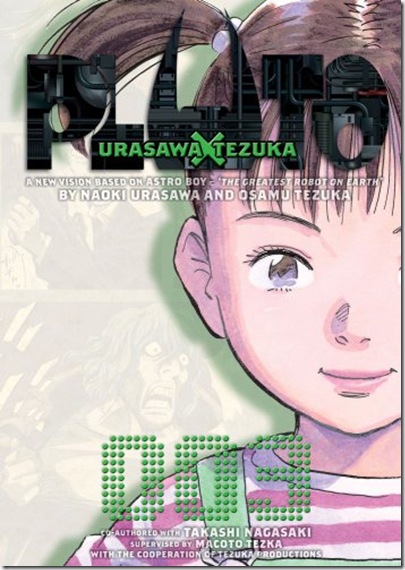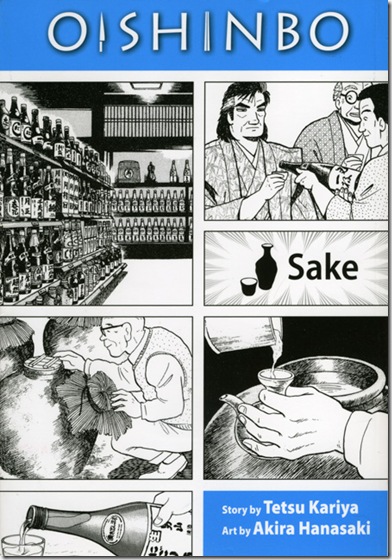This is the first of an irregular series of reviews that will follow a number of titles through their runs – or at least, as far as the publishers allow. This review will cover two manga that are practically polar opposites: Pluto, Vol. 3 – a series that reworks a classic Astro Boy/Mighty Atom tale in a darker, more dramatic manner [think Frank Miller’s The Dark Knight Returns as opposed to the Adam West Batman TV series], and Oishinbo A la Carte: Sake and Ramen & Gyoza – a series about the creation of an ultimate menu of Japanese cuisine.
Pluto: Urasawa x Tezuka, Vol. 3
Volume Three of Naoki Urasawa’s re-working of Osamu Tezuka’s The Greatest Robot on Earth is where the plot really kicks into high gear – and it was not exactly static previously. The robot Europol detective, Gesicht has begun investigating the violent deaths of a number of the most powerful robots on Earth – and the humans who have helped implement the Robot Rights Act.
In Volume Three, we meet Uran, the almost supernaturally sensitive sister of Atom, as she explains to police how she knew that some lions and tigers that had escaped from their transport were scared. It is a moment of humor that comes on the heels of the murders in the first two volumes and allows us to pause for breath before things get hectic again.
We also meet Epsilon, a powerful robot who has become guardian to a host of war orphans, who attempts to persuade Hercules not to seek out the robot killer. Urasawa also introduces a group that is to robots and robot rights what the Ku Klux Klan were [and are] to blacks – and they have a plan to get the Robot rights Act repealed, while also destroying the reputation of Gesicht. But the key to their plan rests on uneasy ground… Finally, we meet the mind behind the plot to murder all the greatest robots in the world – and he isn’t at all what we’re expecting.
Urasawa brings each new development into the tale with a deft touch. His layouts are precisely what they need to be to tell the story; not a panel is waste – nor does he show off. Every technique used is in service to the story. Such care is given to character development that we feel that we know these people; these robots. If anything, in Volume Three, Urasawa’s work – both writing and art – is more focused than in Volumes One and Two. To say that Pluto: Urasawa x Tezuka is, so far, superior to his fine series, Monster, is not hyperbole.
Final Grade: Pluto: Urasawa x Tezuka, volume 3 – A+
Oishinbo A la Carte: Sake
The second volume of the abridged [or highlights] version of Tetsu Kariya and Akira Hanasaki’s Oishinbo undertakes an exploration of Japan’s best known alcoholic beverage, sake. Using the premise of two reporters for the Tozai News attempting to create an ultimate menu of Japanese cuisine, Kariya and Hanasaki have created a platform to deal with not only Japanese cuisine, but relationships – both interpersonal and international. On top of that, we get insight into Japanese history and customs.
In Sake, our intrepid reporters have to deal with both the disdain of Japanese who have lived abroad – and some who have not – for this unique alcoholic beverage. By exploring what and how genuine sake is made – and how times have persuaded many brewers of sake to take shortcuts [often without any penalty; frequently with seeming government approval] – we learn about the kind of discipline and conditions required to create a drink that works better with many cuisines than the finest European and North American wines.
We also see how the dysfunctional relationship between Kaibara Yuzan, founder of the Gourmet Club and his son, Yamaoko Shiro, one of the pair of Tozai News journalists charged with the creation of an Ultimate Menu of Japanese cuisine, extends even to the making and partaking of sake. And both Shiro and his partner in the Ultimate Menu Project learn that many of their fellow journalists believe that they are becoming more than just colleagues working together.
It’s easy to see why Oishinbo has been able to run for hundreds of issues in Japan. Judging from the quality of this translated A La Carte series, so far, the storytelling is lean and crisp; the art continues to be distinctive and the result is both edifying and entertaining.
Final Grade: A
Eclipse Review by Sheldon Wiebe
Posted on June 24, 2009


2 Comments
Comments are closed.